Mexican Cave Explorer Makes History
at
-2000 meters
An
Interview with Gustavo Vela Turcott
By John Pint Photos ©2010 by
their respective authors
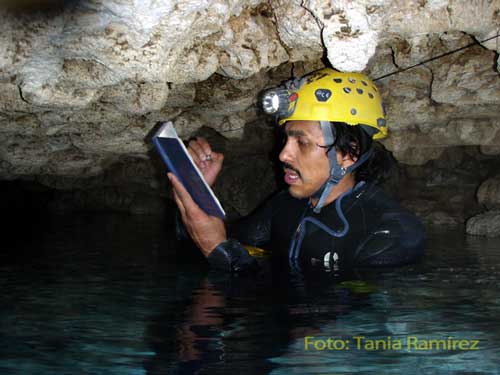
The
place: Krubera-Voronja Cave in Abkhazia, located on the eastern coast of the
Black Sea. The date: August 10, 2006. The first American was about to reach the
bottom of the deepest cave on earth. His name was Gustavo Vela Turcott and he
was from Mexico, not the USA—the first person from the American continent to
climb down to a depth beyond two kilometers.
In his own words, this is what it was like…
“My good friend Alan Warild (Australian expert on vertical caving) was about to
disappear into a horizontal tunnel filled to the top with ice-cold water. He
looked back at me and said, ‘Be careful not to get caught on anything inside the
siphon. Don’t be nervous. Take your time and we’ll meet on the other side.’ Then
he took a deep breath and disappeared into the murky waters. We were at a depth
of -1440, inside the world’s deepest cave, standing waist-deep in water whose
temperature was about 5 degrees Celsius. The roof of the passage we had been
walking in sloped downward until it touched the surface of the water. My teeth
were chattering but I couldn’t tell whether it was from the water temperature or
from the sheer terror that was coursing through my veins. I had both of my
headlamps on, but I couldn’t see farther than three meters because of the fog
generated by the body heat of the cavers who were now on the other side of the
siphon. On top of that, the walls of the passage were much darker than anywhere
else in the cave. In spite of all this, my instructions were not to be nervous!
So, I calmed myself down, put on my diving mask, squeezed the air out of my dry
suit, took a deep breath and plunged into the icy water…”
| There are 89 caves in the world that are over a kilometer deep (nine of them in
Mexico, by the way) but only one which passes the -2000 mark. Kruber-Voronja is
a very vertical cave with many big drops, one of them measuring 152 meters. It
has plenty of cold, tight, muddy passages and a few confusing spots where you
could easily get lost. Above all, it is an Alpine Cave, meaning it’s about 3° C
cold, something like being inside a refrigerator.
Gustavo Vela in Kruber-Voronja.
Photo by Al Warild.
|
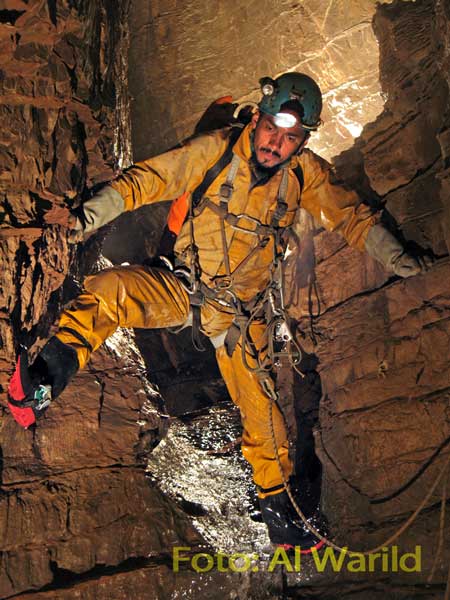 |
Gustavo Vela continues:
“I opened my eyes and just as they had told me, I couldn’t see more than 50
centimeters ahead because the mud at the bottom had been stirred up by the first
person to go through. I grabbed on to the lifeline running through the siphon
and pulled myself forward. What started out as a passage about one meter around
was soon only 50 centimeters wide and 70 high and I covered the last two meters
on my knees until I suddenly saw a bright light coming from above the surface.
And there were my friends Denis and Alan waiting for me with big smiles and
hefty pats on my back. ‘You did it!’ they shouted. A few minutes later, at
exactly 10:59 PM, I reached a depth of -2080 meters and set a new record for
Mexico and the Americas. Now the only goal I had was to get back up to the
surface and—after five days underground—to finally take a much-needed shower.”
| Gustavo Vela Turcott was born in Mexico City in 1973. He is the author of Un
Viaje al Mexico Profundo (A Voyage to Deepest Mexico), published in 2005 by
Editorial Santillana, Mexico City. This volume is, in my opinion as a long-time
caver in Mexico, the finest book on Mexican caves and caving so far produced.
Un Viaje al Mexico Profundo by Gustavo Vela Turcott, has 180 pages in
color and 200 photos. ISBN:
970-29-1272-5,
Editorial Santillana, Mexico City, 2005. Available directly from
the author (turmalinero@yahoo.com).
|
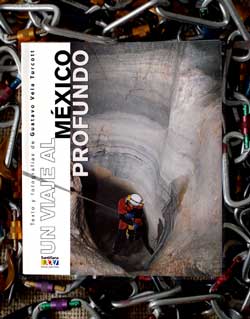 |
I caught up with Gustavo Vela not long ago during an International Congress of
Speleology and--for Subterráneo magazine and the Guadalajajra Reporter--I asked
him a few questions about his passion for exploring deep caves.
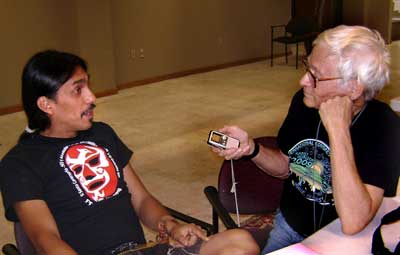
Subterráneo: Gustavo, please tell us how you got started caving.
Gustavo Vela: It all began when I joined the UNAM (Mexican Autonomous
University) mountain-climbing club. I knew nothing about Speleology, but in 1994
they took us to a cave and I liked it. In 1997 they offered a technical course
in Speleology and from then on I was hooked.
Subterráneo: You have been inside some of the world’s deepest and
most dangerous caves…so, what was your greatest adventure?
Gustavo Vela: Surviving in Mexico City! It’s the toughest challenge of
all and every day brings a new adventure.
Subterráneo: I believe it, but tell us about your first international
expedition.
Gustavo Vela: This took place in 1999. It was to Teocolote Cave in the
state of Tamaulipas and it was led by Texans. We camped for seven days and it
was the first time I really got involved in speleological exploration. All my
previous experiences had been sport caving. I really loved the challenge and
with every trip, I’ve enjoyed it more and more.
| Subterráneo: And after that?
Gustavo Vela: Well, one expedition has always led me to another, like a
snowball rolling down a mountainside. I meet somebody who knows somebody else
and off I go again. And that’s how I got involved in the Charco Expedition,
which took place in the year 2000, the same year I joined The Mexican Society
for Underground Explorations (SMES). I had always dreamed of doing a cave 1000
meters deep and I finally got the chance, in Charco.
Gustavo Vela on rope in 815-meter-deep Cueva
Tres Quimeras in Puebla. Photo by Al Warild
|
 |
Subterráneo: I believe it, but tell us about your first expedition to a
deep cave.
Gustavo Vela: Well, that would be an expedition to a cave called Charco,
which took place in the year 2000, the same year I joined The Mexican Society
for Underground Explorations (SMES). I had always dreamed of doing a cave 1000
meters deep and I finally got the chance, in Charco.
Subterráneo: Where is Charco and what’s it like?
Gustavo Vela: Charco is located in the northern part of the state of
Oaxaca. I had joined an international expedition organized by two U.S. cavers.
The cave had been found in 1989 and seemed to lead down to one big puddle (charco
in Spanish). This was bypassed in 1993 and led cavers to very, very narrow,
tight passages and a series of short drops. Although the cave was difficult,
people continued to push it in the hope that it would eventually connect with
Mexico’s more famous Sistema Cheve which is now 26 kilometers long. Over the
years there were a lot of deserters because of how difficult this cave proved to
be. Eventually it passed 1000 meters in depth. That far down, there were no
places to camp at all and cavers had to sleep in hammocks attached to bolts set
into the walls. Dye tests proved that Charco is hydraulically connected to Cheve,
but no human being has ever been able to make the connection. The cave is so
muddy, humid, slippery, cold and tight that I would call it one of the most
inhospitable and lonely places on this planet. At 1278 meters deep, it is
presently the third deepest cave of Mexico.
Subterráneo: Wow! How did you manage to top that?
Gustavo Vela: Well, in 2003 I participated in an expedition to Cheve.
They had reached a depth of 1,386 meters, set up three permanent underground
camps and had mapped 24 kilometers of passages, but they were stuck at a sump no
one had been able to get through. Forty-five people from eleven nations
participated in our expedition and on this occasion four divers, led by Bill
Stone, succeeded in negotiating the sump, which was 140 meters long, only to
come to another sump, this time 282 meters long. They also got through this one
and reached a depth of 1484 meters, making this the deepest cave in Mexico and
the eleventh deepest internationally. Since the limestone at Cheve has a
vertical potential of over 2500 meters, there is hope that this might someday
end up being the deepest cave in the world.
Subterráneo: So all this made you thirsty for a 2000 meter-deep cave?
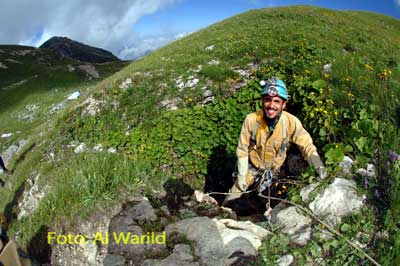 Gustavo Vela: Of course. Now, in 2005 I met Alan Warild, who has done
more than eight solo trips to caves over 1000 meters deep. He was talking about
how he had been in Krubera-Voronja, the deepest cave in the world, and I said,
“I want to go, I want to go!” Then one day I got a message from him: “Gustavo,
prepare your gear; we’re going to go.” But later he sent another message, from
Australia: “Sorry, the expedition is full, wait until next year.” Then we got
together again in 2006 at J2, another cave over a kilometer deep, in Oaxaca.
“Alan,” I said, “don’t forget about Voronja.” In June he told me I was on the
list and it was really going to happen. Well, I started working like crazy to
save up money, borrowed cash here and there, and in July I was on a plane to
Abkhazia. The only real problem I encountered there was being forced to shave my
beard off. The Russians claimed I looked like a Chechen terrorist...and they
weren’t kidding!
Gustavo Vela: Of course. Now, in 2005 I met Alan Warild, who has done
more than eight solo trips to caves over 1000 meters deep. He was talking about
how he had been in Krubera-Voronja, the deepest cave in the world, and I said,
“I want to go, I want to go!” Then one day I got a message from him: “Gustavo,
prepare your gear; we’re going to go.” But later he sent another message, from
Australia: “Sorry, the expedition is full, wait until next year.” Then we got
together again in 2006 at J2, another cave over a kilometer deep, in Oaxaca.
“Alan,” I said, “don’t forget about Voronja.” In June he told me I was on the
list and it was really going to happen. Well, I started working like crazy to
save up money, borrowed cash here and there, and in July I was on a plane to
Abkhazia. The only real problem I encountered there was being forced to shave my
beard off. The Russians claimed I looked like a Chechen terrorist...and they
weren’t kidding!
Subterráneo: What was the hairiest experience you had underground?
Gustavo Vela: I had several of this kind of experiences. One took place
in 2007. I was with Al Warild and Franco Attolini in El Santo Cavernario. It had
been raining all the time we were underground and when we came out, we were at
the bottom of a pit 134 meters deep and discovered that there was now a
waterfall coming down on top of us and our rope was underneath it. We got out,
but climbing 134 meters while fighting a waterfall was definitely a hairy
experience.
Subterráneo: Would it be right to say that you eventually became a
collector of kilometer-deep caves?
Gustavo Vela: Yes, after exploring -1000 deep caves in Mexico, I went
into several more in Spain and one in France and finally I set myself a personal
challenge: I had to find a minus-one-thousand all on my own…and last March I
finally succeeded, although not all by myself. I was with a small group of
dedicated cavers and we found El Santito Cave in Puebla.
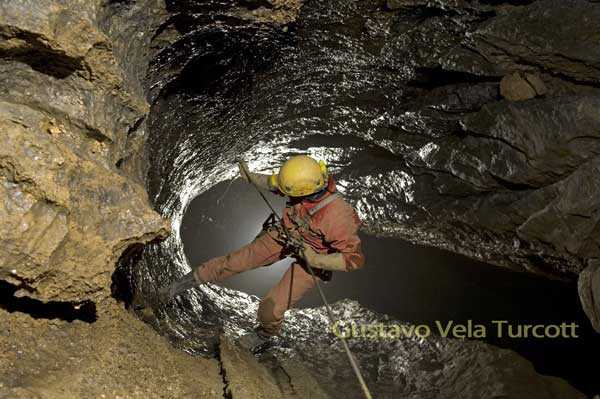
Subterráneo: What’s the story? How did you find El Santito?
Gustavo Vela: Well, Al Warild, Franco Attolini and I have this project in
Puebla, in the south. We were looking for the entrance to Akemabis in 2007, but
we didn’t know where it was. Along the way we found several cave entrances. One
was very tight, with lots of air flow. The following year we went back to this
cave and followed it for 527 meters. And in 2009 it took us down to -1127
meters. So I told Ramón Espinasa: “OK, we did it, we found a “menos mil” all on
our own—finally I can retire from Speleology.”
Subterráneo: So, are you ready for retirement?
Gustavo Vela: Not exactly. In fact, next I may go to China with an
English expedition, hoping to learn new things, and without a doubt we will be
returning to our area in Puebla, because we have unanswered questions and caves
that are still going.
Subterráneo: So, can we expect another book to be coming out soon?
Gustavo Vela: I don’t know. Wait until I retire, and then I’ll start
thinking about it. Hmmm, but seriously, I wouldn’t mind doing another cave
book…it would be a good challenge.
Subterráneo: Considering your record with other challenges, we’re already
looking forward to that book.
If you have recently come across a 3000-meter-deep cave and would like to
tell Gustavo about it… or if you’d like to purchase a copy of his book A
Journey to Deepest Mexico, you can email him at
turmalinero@yahoo.com.
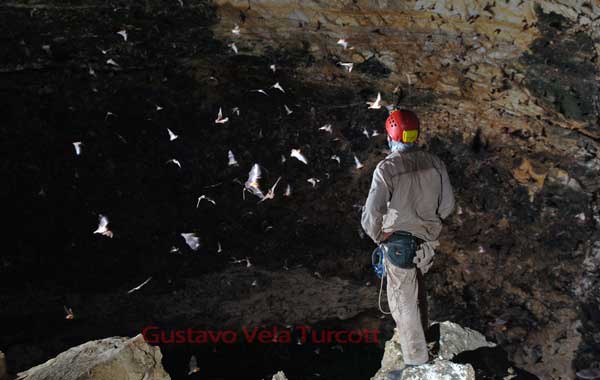
Volcán de los Murciélagos by
Gustavo Vela Turcott
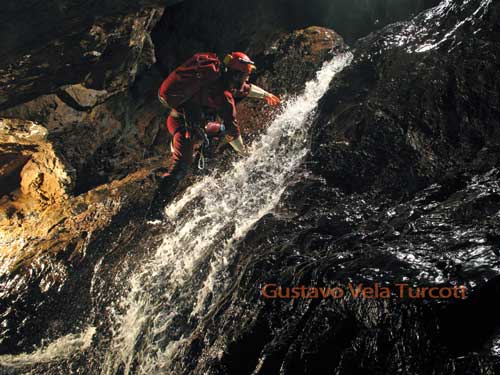
Guillaume Pelletier in Tres Quimeras Cave in Puebla,
Mexico --
by Gustavo Vela
Turcott
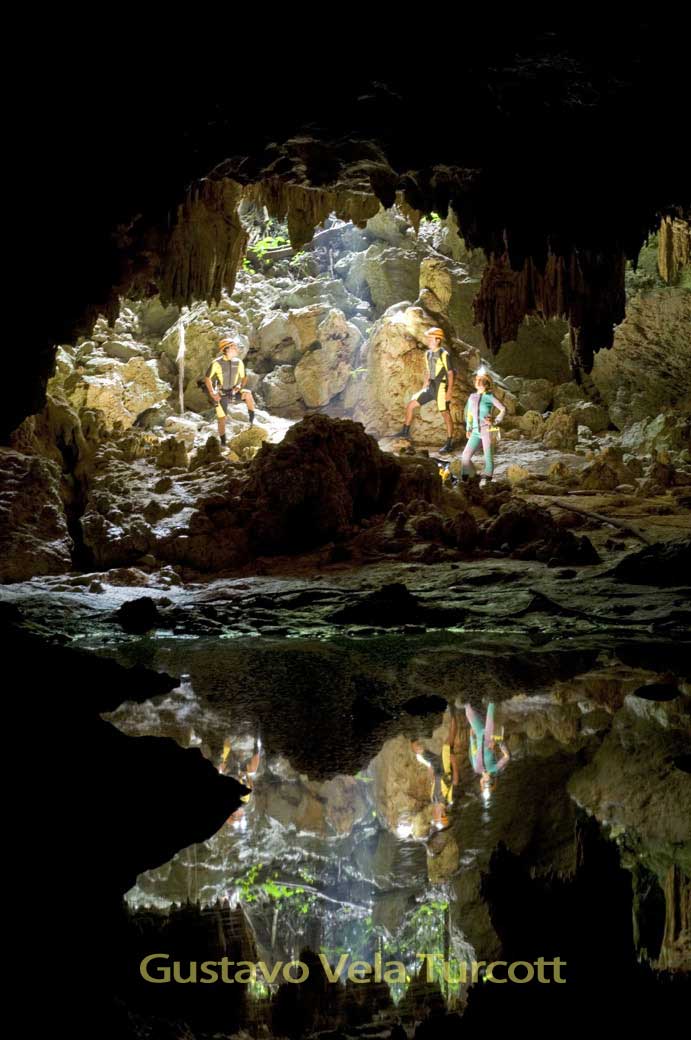
Sistema Yok Ha-Hanil, Quintana Roo. Photo by Gustavo
Vela Turcott





 Gustavo Vela: Of course. Now, in 2005 I met Alan Warild, who has done
more than eight solo trips to caves over 1000 meters deep. He was talking about
how he had been in Krubera-Voronja, the deepest cave in the world, and I said,
“I want to go, I want to go!” Then one day I got a message from him: “Gustavo,
prepare your gear; we’re going to go.” But later he sent another message, from
Australia: “Sorry, the expedition is full, wait until next year.” Then we got
together again in 2006 at J2, another cave over a kilometer deep, in Oaxaca.
“Alan,” I said, “don’t forget about Voronja.” In June he told me I was on the
list and it was really going to happen. Well, I started working like crazy to
save up money, borrowed cash here and there, and in July I was on a plane to
Abkhazia. The only real problem I encountered there was being forced to shave my
beard off. The Russians claimed I looked like a Chechen terrorist...and they
weren’t kidding!
Gustavo Vela: Of course. Now, in 2005 I met Alan Warild, who has done
more than eight solo trips to caves over 1000 meters deep. He was talking about
how he had been in Krubera-Voronja, the deepest cave in the world, and I said,
“I want to go, I want to go!” Then one day I got a message from him: “Gustavo,
prepare your gear; we’re going to go.” But later he sent another message, from
Australia: “Sorry, the expedition is full, wait until next year.” Then we got
together again in 2006 at J2, another cave over a kilometer deep, in Oaxaca.
“Alan,” I said, “don’t forget about Voronja.” In June he told me I was on the
list and it was really going to happen. Well, I started working like crazy to
save up money, borrowed cash here and there, and in July I was on a plane to
Abkhazia. The only real problem I encountered there was being forced to shave my
beard off. The Russians claimed I looked like a Chechen terrorist...and they
weren’t kidding!


